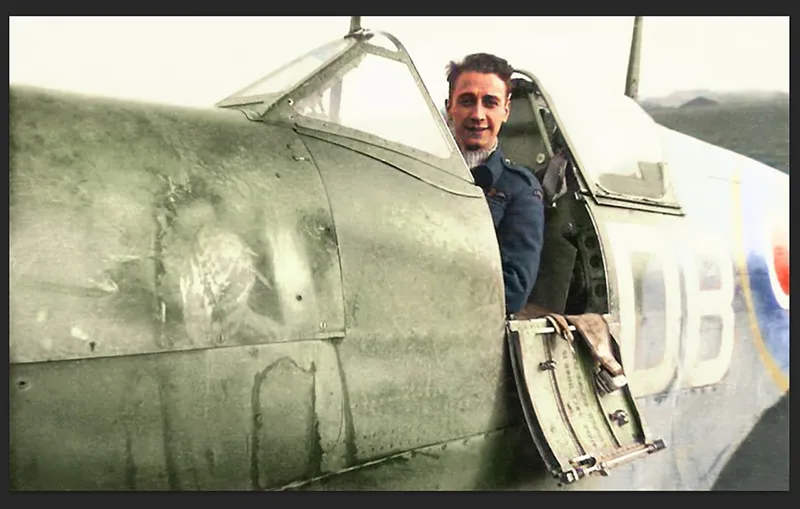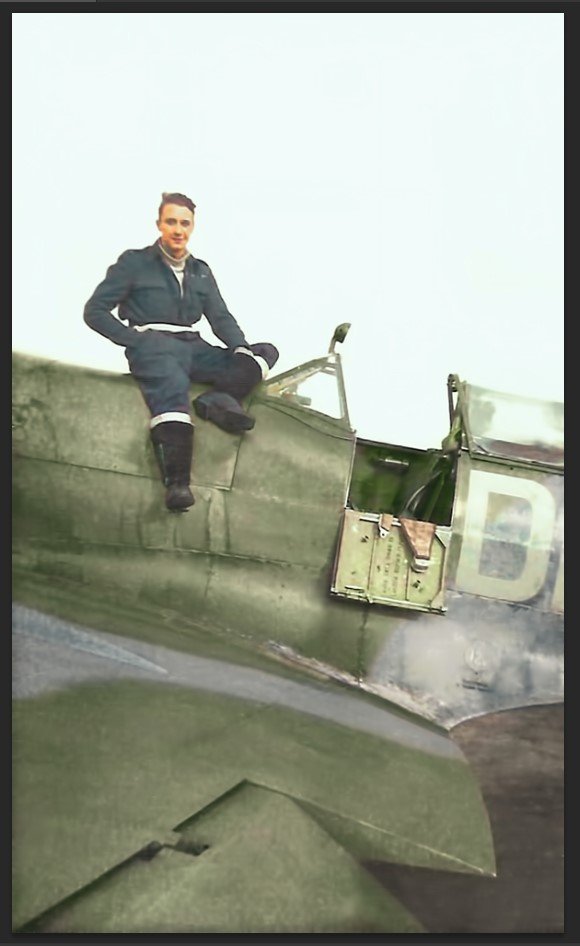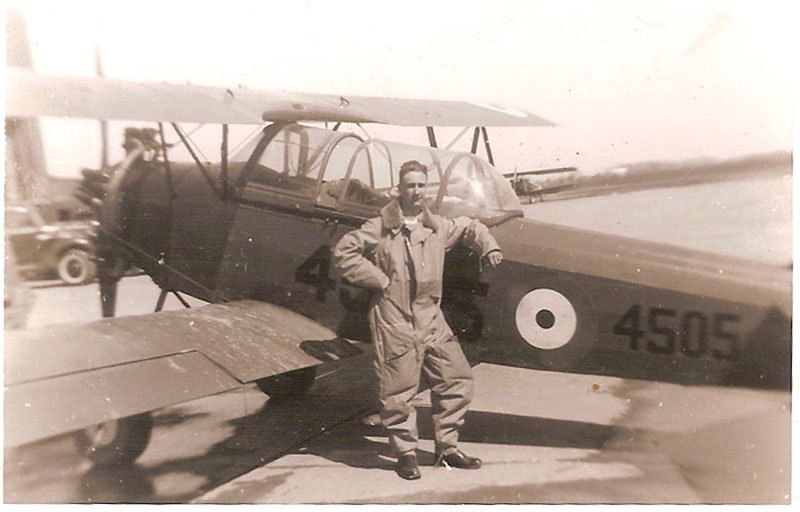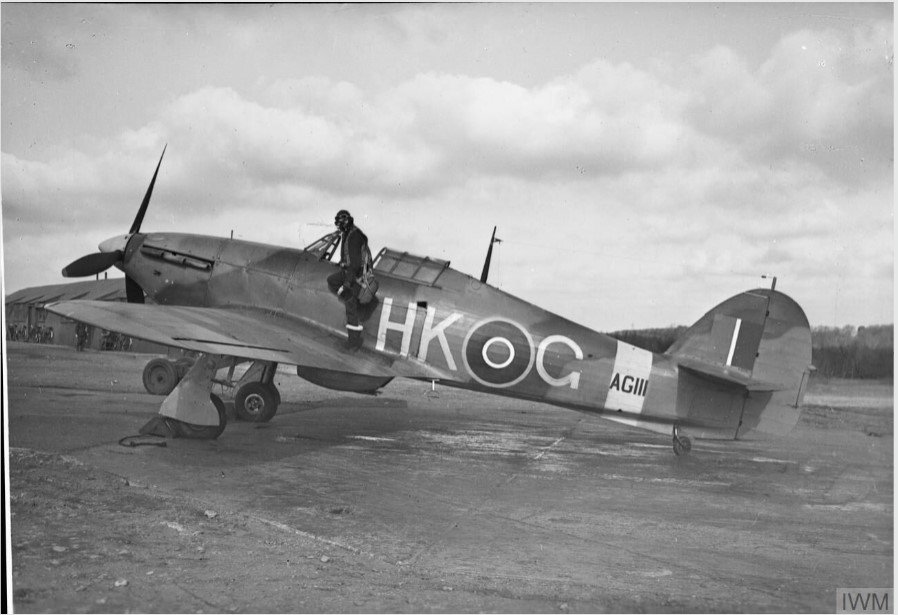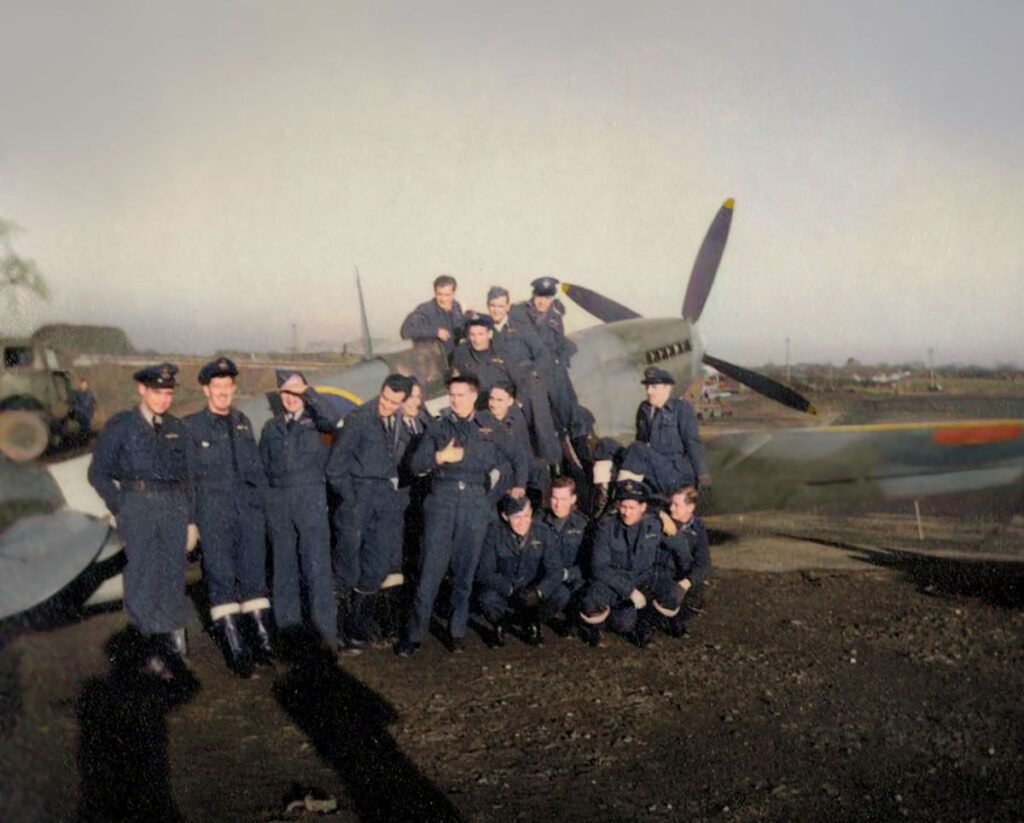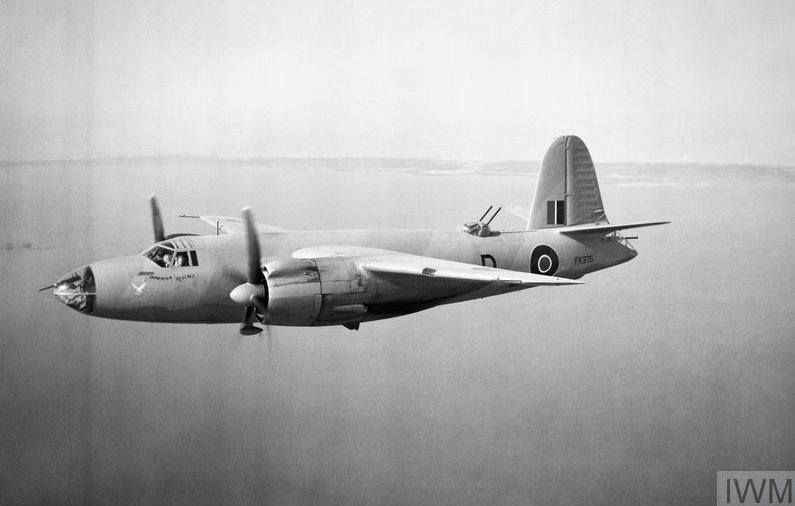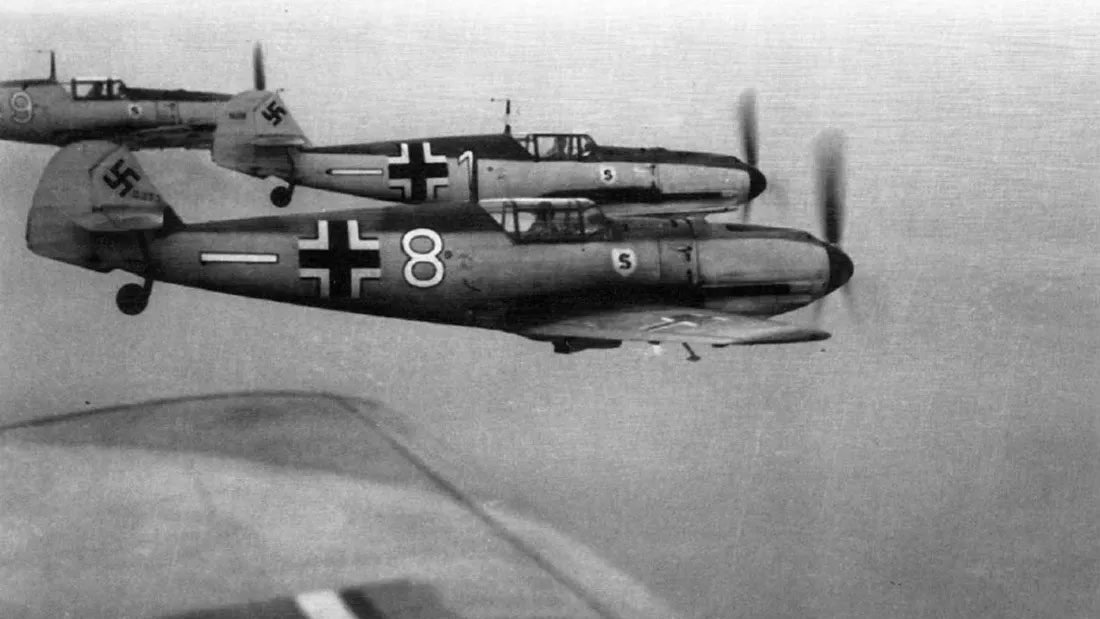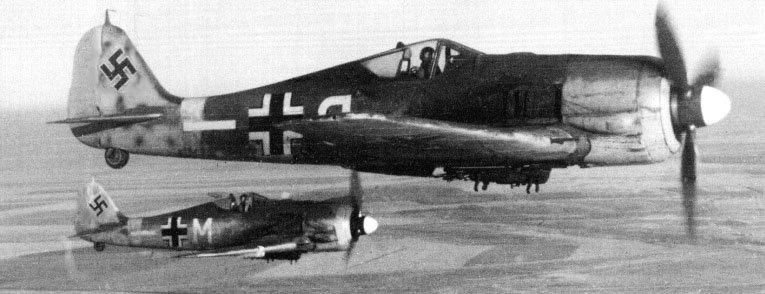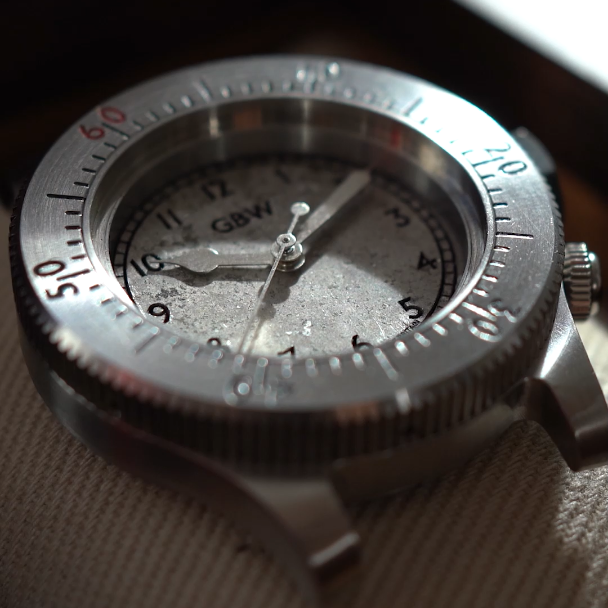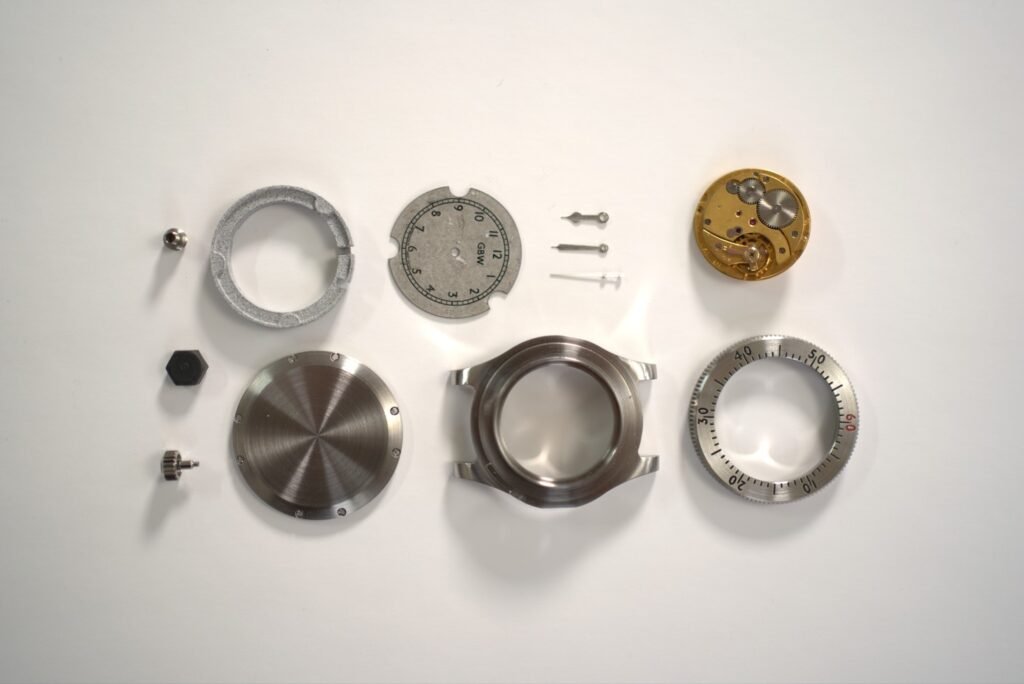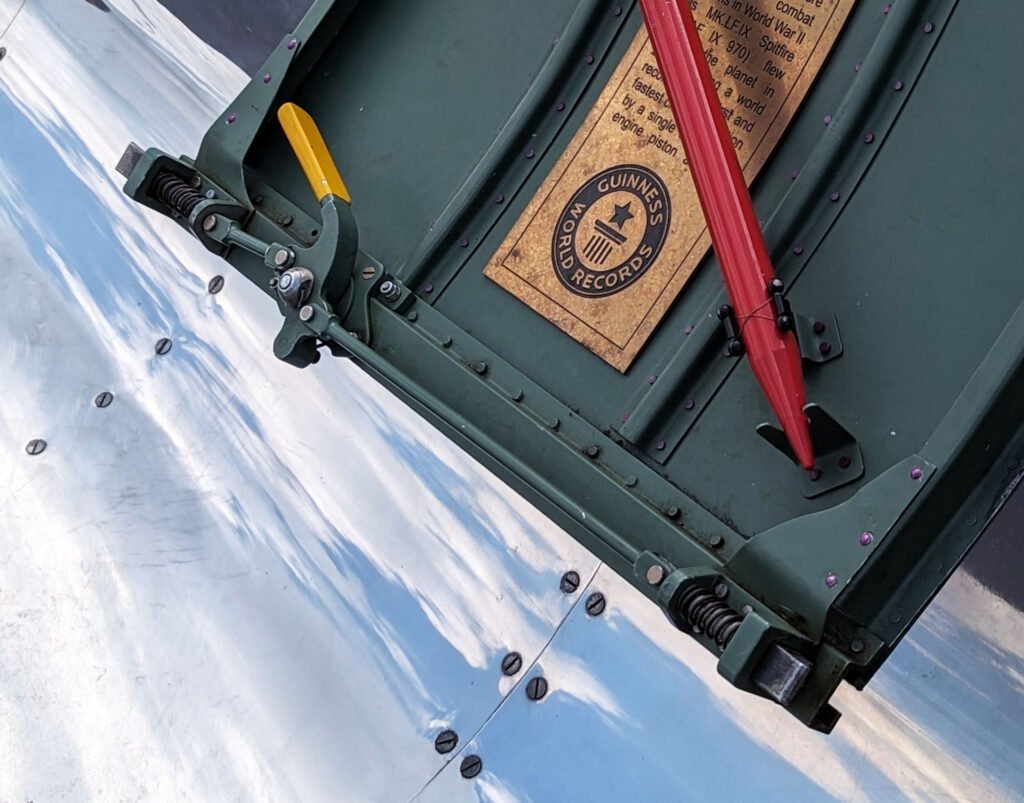80 years ago, Spitfire ML295, piloted by Harold Kramer of 411 Squadron, was hit by anti-aircraft fire while flying on a mission in Northern France. Kramer, known as Hal to his wartime friends, managed to glide his Spitfire down safely and make an escape.
This Spitfire has now been recovered and restored and is flying again from Biggin Hill Airfield, with part of the original aircraft being used in the creation of The Few, a watch I am making (a full breakdown of the progress of this project is at the end of this Sortie).
Harold “Hal” Kramer sat in a Spitfire, possibly ML295
Spitfire ML295 flew 67 combat missions in total, with 37 of those sorties flown by Hal. Although 10 other airmen in the squadron took the pilot’s seat, they all, along with Kramer himself, would have viewed Spitfire ML295 as Hal’s personal aircraft. The hand-built nature of war-time Spitfires meant that each aircraft was slightly different, having their own quirks and characteristics – something akin to a personality, which the pilots became attached to. There is also some chance that the Spitfire was named after Harold’s wife Dorothy, or Dot, with her name painted underneath the cockpit door.
The story of Spitfire ML295 is therefore closely intertwined with that of Harold Kramer.
We will start this 4 part biography with Hal training to become a pilot, his first operational missions and the start of his life in the Squadron.
Part 1 – An Ordinary Hero
Kramer was one of the core “founding” members of 411 Squadron, a group of Spitfire pilots from Canada who gave themselves the moniker the Roaring Boys – perhaps due to their habit of letting out a roar when the MGM lion appeared during the start of a film.
Around this core, the squadron’s culture, camaraderie, humour and work ethic was set, leading 411 Squadron to regarded as one of the most successful Spitfire squadrons in the war.
Hal posing with a newly delivered Spitfire
Like many people that were active during the war, once they had returned home they dealt with the many traumatic events they had witnessed by trying to put it to the back of their mind, and not talk about their experiences. Although Harold is no longer alive to ask, and his personal logbook has been lost, we are thankfully able to piece together a compelling story from the squadron’s records and official reports, which often make reference to Hal.
Both Kramer and Spitfire ML295’s stories are one of service, dedication, sacrifice and ultimately, survival.
Harold Kramer
Harold was born in 1919 in Port Colbourne, a small town not far from Niagara Falls in Ontario, Canada. Being just 20 when the war broke out, Harold had made an early decision to become actively involved in the war effort. While studying mechanical engineering at the University of Toronto he enrolled in the university’s auxiliary battalion, where he would have been introduced to the discipline of the armed forces.
Being a pilot in the war was heavily romanticised
After graduating in 1941, Kramer moved into the Reserves of the Active Militia before taking a summer job at the International Nickel Company in his hometown. On 20th August 1941, Harold travelled to Hamilton and signed up at the Royal Canadian Airforce (RCAF) Recruiting Centre, volunteering to be a pilot. Two weeks later his flight training began.
Learning to Fly
After the success of the Battle of Britain, Fighter-Command wanted to improve the pilot training situation and so through the British Commonwealth Air Training Plan, volunteer pilots in Canada were trained to prepare them for front line operations against the Luftwaffe. Their instructors included pilots who had flown during the Battle of Britain and they were able to pass on their valuable learned experience.
Hal Kramer in 1941 at the Elementary Flying Training School in London, Ontario. He is alongside a Fleet Finch, which was a locally produced biplane that pilots spent their first 50 hours of flying in
By this time in the war the Spitfire was a proven aircraft, with the limits of its performance and capabilities fully tested. The pilots were trained to know their Spitfires inside out and flew them like an extension of their own bodies. They were also fully aware of all the types of German aircraft they would encounter, what each type was capable of, and which tactics to use to defeat them.
These young men were not just professional pilots, but professional Spitfire pilots, specifically trained to face and neutralise the current German threat.
A year after Kramer volunteered as a pilot, he earned his wings and was given the non-commissioned to the rank of Sergeant. In the two weeks of leave before he was due to ferry out, he married his sweetheart Dorothy, and then after saying his final goodbyes, Hal left for England and the war.
After leaving for England, Hal would not see his new bride again for over a year
Training to Become a Fighter Pilot
Arriving in November 1942 at No. 5 Advanced Flying Unit (AFU) based in RAF Tern Hill in Shropshire, Hal began training on a Miles M.9 Master, an advanced two-seater trainer aircraft that was used as an introduction to high performance fighter aircraft such as the Spitfire and Hurricane.
After spending a month getting to grips with the Miles Master, Kramer was now an accomplished pilot, comfortable in an array of aircraft. He was ready to start the final part of his training; to become an effective fighter pilot.
A Hurricane at the No.59 Operational Training Unit, coincidentally with Harold’s initials on its flanks
Moving to the No. 59 Operational Training Unit (OTU) at RAF Milfield in Northumberland, Hal was introduced to the Hurricane. Being the first single-seater aircraft that he had flown in, it was also the first time that he would have flown solo and so would have had a good mixture of nerves and excitement as he took off from the runway.
Not long after, his dream became a reality and he converted from flying Hurricanes to Spitfires.
At RAF Milfield the training was intense, relentless and thorough. Over the next 6 months Kramer practiced everything from formation flying to writing military reports. He learned his gunnery skills and tail chasing – a cat and mouse game where pilots took it in turns to try and follow the lead aircraft while they in turn tried to shake them off.
Link Trainer
Part of the ongoing training that continued even after Hal was operational, was to use a Link Trainer. Named after the developer, Edwin Link, the trainer was the world’s first flight simulator, boasting an accurate cockpit and controls that provided feedback to the pilot and hydraulically turned and tilted them as they moved the flight stick.
Although used to help teach pilots a number of skills, it was predominately used to practice flying blind or by instrument only, to prepare them for situations where visibility was zero – such as at night or in heavy fog.
Link Trainer, the world’s first flight simulator
If you are interested in learning more about this amazing piece of machinery, here is a video of Guy Martin using a Link Trainer: https://www.youtube.com/watch?v=qhGGljiUR2c
Joining 411 Squadron and Hal’s First Mission
Now with almost 2 years of intense training behind him, Hal was deemed ready for front line operational flying and was assigned to 411 Squadron, based at RAF Redhill in Surrey, where he joined them on 12th July 1943.
411 Squadron, with Kramer standing in the very centre of the photo
After a few days to settle in and meet his squadron mates, Kramer took off on his first sortie on 16th July 1943. He was flying in a Spitfire Mark 5b, registration BL347.
The Squadron’s notes detail the mission:
“A Ramrod operation to Abbeville marshalling yards by 16 Marauders escorted by 401, 412 and 411 Squadrons was carried out. Wing Commander Russel led the escort to the rendezvous at Beachy Head at 19.45 hours at 11,500 feet, crossed the French coast at the Somme estuary at 11,500 feet at 20.05 hours, and to the target at 20.10 hours. The bombing results were not observed by the escort. Medium flak, accurate for the height was encountered. On the way out approximately five miles south of Bayeux No 412 Squadron was attacked by two F.W. 190’s of some 15 to 20 in the vicinity. The enemy aircraft were out of range when they fired and broke away immediately. The cloud formation over the channel was 5/10 cumulus. At the target, however, visibility was unlimited. No shipping was observed, all aircraft returned to base.”
Kramer’s first mission report
Kramer’s next mission was not until 27th July 1943, when he was part of a sea rescue mission to find the Squadron Leader of 412 Squadron. Due to engine trouble on a sortie earlier that day, the pilot had been forced to bail out into the English Channel just off the French coast. The weather wasn’t good however, and they were only afforded a 15 minute window to search for the pilot, which proved unsuccessful. Thankfully the pilot was later safely rescued by a Walrus aircraft – an amphibious bi-plane designed by the Spitfire’s creator, R. J. Mitchell.
B-26 Marauder
The B-26 Marauder, the bomber that Hal had escorted in his first mission, was a difficult aircraft to fly, particularly during take-off and landing, as the aircraft had the tendency to stall and crash unless a high speed, 150mph, was kept up on the final runway approach. Owing to the regularity of accidents, B-26 crews gave the aircraft an assortment of unflattering nicknames including Widowmaker, Martin Murderer, Flying Coffin, B-Dash-Crash, Flying Prostitute and Baltimore Whore – named for the city where the B-26 was built.
When the B-26 came to Europe, initially the tactics used were copied from those that had been tried and tested in the North African campaign, which involved flying low and unescorted. However, on the second mission flown by the B-26 in Europe, these tactics resulted in all 11 aircraft being lost to enemy aircraft and flak.
The Martin B26 Marauder was an American-made medium bomber
The Ramrod
This horrific loss resulted in a swift change of tactics to ensure that the Marauder would never fly without a fighter escort again. It was also ordered to keep to an altitude of between 10,000-15,000 feet (3,500-5,000m). Thus, the Ramrod mission was born.
The majority of 411 Squadron’s sorties during 1943 and early 1944 were Ramrods, operations where the Spitfires provided fighter cover to B-26 bombers attacking targets in German occupied Europe.
With this change in tactics, the Marauder grew to be considered not only one of the most accurate late war bombers available, but also the safest, with a reported operational loss rate of just 0.5% in the European theatre.
On 7th August 1943, the squadron relocated to RAF Staplehurst in Kent, where over the next few months, the Roaring Boys enjoyed great success in their escort duties, with almost all of the Ramrod missions successful – with targets bombed, no enemy aircraft engaged and no friendly aircraft lost.
The exception to this was on 2nd September 1943 when a Martin B-26 Marauder was hit by anti-aircraft flak and exploded with all 7 crew perishing. This would have been the first time that Kramer would have witnessed death so close up, and during the dozens of Ramrod sorties flown by 411 Squadron it was the only loss of an escorted bomber.
First Contact
On one mission while escorting a group of 72 B-26 Marauders, they were attacked by a group of Focke-Wulf 190 (FW190) fighters, and later a larger group consisting of a mix of 20 Messerschmitt Bf109 and FW190 aircraft.
In the resulting melee, before the Spitfires were able to chase the Luftwaffe aircraft away, some of the bombers were badly shot up, but nevertheless survived. During the engagement, one of the Spitfire escorts flown by Flying Officer Haw was shot down – with the pilot reported missing. At the time, the fellow pilots were unaware of Haw’s fate, although post-war records show that he survived and became a prisoner of war. This incident was Kramer’s first encounter with engaging enemy fighters on a mission, providing him with a taste of both the dangers and excitement of air-to-air combat.
The Bf109 built by Messerschmitt was the Luftwaffe’s main single engine fighter used during WW2
The FW190 built by Focke-Wulf was more robust and heavily armed than the Bf109 and earned a fearsome reputation
Relaxation
It wasn’t all hard work though. On rainy days where no flying took place, the boys made themselves busy with socialising and relaxing. One typical free day was spent by them all going for lunch, followed by a trip to the local swimming baths, then the “flicks” (cinema), before a pub crawl which ended up at a dance pavilion.
A variety of games and sports were played including table tennis, badminton, basketball, volleyball and clay pigeon shooting. A competitive element was often added, with everyone chipping in to a pot for the winner.
There was even an inter-squadron baseball league, however this wasn’t 411’s strong point and in their first game against 401 Squadron, they were beaten by 6 points.
The Roaring Boys enjoying a game of volleyball. In one such game on 18th September 1943, Tommy Wheler, who we talked about in Sortie 15, had an accidental knock into Squadron Leader Semple which dislocated his boss’ knee! The injury meant an end to Semple’s flying career, with Ian Ormston taking over command
Part 2 – Mark 9 Spitfire
The Roaring Boys of 411 Squadron were all excited to learn that their new Spitfires, Mark 9 (IX) variants, were due to arrive shortly and would be ready for their upcoming big move to Biggin Hill Airfield. The Mark 9 was designed to be a quick fix upgrade from the Mark 5 variant that the Squadron were currently using. It was specifically designed to counter the threat posed by the Luftwaffe’s Focke-Wulf 190 (FW 190), which the Mark 5 Spitfire had found itself outclassed by since Summer 1941.
The introduction of the Spitfire Mark 9 marked a turning point in the air war from which the Luftwaffe would never recover
The Mark 9 however proved to be so successful that it remained in use through to the end of the war and went on to become one of the most produced Spitfire types. Initially built around the Mark 5 frame, but with a new two-stage supercharged Rolls-Royce Merlin 61 engine fitted, the increased power gave the Mark 9 Spitfire more speed, climbing power and performance at altitude, and was now in a position where the Spitfire overshadowed every fighter the Luftwaffe was able to muster.
The squadron’s eagerness for their new aircraft would have to wait however, as bad weather crept in and postponed their move.
As they were unable to fly, their time was well spent on other activities including practicing escaping from behind enemy lines.
Escape and Evasion Training
With advances in safety for Spitfire pilots, such as self-sealing fuel tanks and cockpit armour, being in a downed aircraft was becoming increasingly survivable. As the fighting in the air had moved from being defensive over England, to offensive in occupied Europe, this meant that if a pilot was shot down while on a mission, they were now behind enemy lines. So, it was important for the pilots to learn the art of remaining hidden and how to navigate their way back to safety.
In total the pilots of 411 Squadron, including Kramer, took part in three evasion training events. Each of these attempts appears to have been a large exercise that involved pilots from other local squadrons. For each pilot that made it back safely they won their squadron 15 points – although who the overall winners were was not recorded.
A pilot’s brass tunic button that when unscrewed revealed a secret compass
The rules were that the pilots would be taken to a set distance from the airfield and released. Between the pilots and their goal, the intelligence tent at the airfield, was a cordon of Home Guard, Army and local Service Police. The pilots were not allowed to speak at any point, nor were they allowed to use violence in their attempted return to the airfield – but everything else was permitted. If they were touched by anyone, they were deemed captured, and to aid them in their escape each pilot was given two pence in cash and a compass.
Practice Makes Perfect
In the second of these exercises, they were taken 8 miles away from their goal.
Arriving at 11am, the pilots spent the first hour orienting themselves using their escape map and compass, before splitting up into smaller groups and starting on their way back to the airfield.
One of these groups decided to try to head on a direct path back, frequently having to dive for cover when both foot and motor patrols passed by. After a few close calls, by 3:30pm they were exhausted but had arrived at a nearby village and made an attempt to steal a car. Unfortunately, the car’s owner caught wind of their plan and chased them down the road.
They had more luck with two bicycles that were swiftly borrowed without permission, and they made their way to the outskirts of the airfield. Having almost made it back they were spotted by a motorcycle patrol and so had to ditch the bicycles and flee into a field with the RAF Regiment in hot pursuit. Now exhausted, the men spotted a group of soldiers in a farmyard and so hid behind some barrels. While deciding their next move they heard a shout of “the game’s up” and looked up to see a bayonet pointed at them.
A member of the RAF Regiment with his bayonet fixed
Although this group wasn’t successful, many were, with one group of pilots heading to a nearby airfield where they “borrowed” 3 Spitfires, as well as a Tiger Moth, a bus and a van, aiding them in making it back safely.
Only 3 pilots were able to make it back without stealing anything – highlighting that the most resourceful airmen were the most successful.
The borrowed equipment was all returned the following day.
Importance of the Training
Tommy Wheler, who we discussed in Sortie 15, remembers that although they acted within the rules of the game, their shenanigans in stealing the Spitfires during the exercise were considered “not cricket”. This caused a lot of friction with the RAF, particularly as the Spitfires they had borrowed were the top-secret Mark 12 variants that had not yet been made public.
A Spitfire Mark 12, which was powered by a Rolls Royce Griffon engine
As a demonstration of how vital such training was, within the next 10 months three of Spitfire ML295’s pilots would be shot down behind enemy lines, with all three pilots managing to effectively evade capture and make it back safely to Allied lines.
Concerning the training, 411’s Squadron Leader wrote “The escape exercise was a success and our pilots have exhibited success in yet another field. When we are equipped with Spitfire IX’s these keen boys should pile up an imposing Squadron victory score! This is the haven of their desires”.
Move to Biggin Hill
After many delays due to poor weather, on 13th October 1943 the Squadron finally relocated to Biggin Hill Airfield, where their brand-new Spitfire Mark 9s were waiting for them.
They spent the first week in their new accommodation decorating and cleaning their sleeping quarters and communal areas. One of ML295’s pilots, Bob Hyndman, was the Squadron’s artist and he painted three murals, two of naked women, and the third was pencil sketch above the fireplace that was a map of Canada with portraits of each of the current Squadron’s pilots with arrows pointing on the map to their hometown.
Whenever the weather would clear, they would take the opportunity to practice flying in their new Spitfires, keeping in formation as well as practicing using their cine cameras, and by 22nd October they began flying their new Spitfire Mark 9s operationally.
Spitfires flying over RAF Biggin Hill
On 23rd November 1943, Kramer was finally promoted from a Flying Sergeant (F/S) to a Pilot Officer (P/O), after being commissioned as one on 1st September. However any celebrations he had planned were cut short, as he was immediately sent on another Ramrod sortie.
Tragedy Over the English Channel
Taking part in Ramrod 326, Kramer was part of the escort for 72 Marauders who were set to bomb the Lille-Vendeville Aerodrome. On the way to the target one of Hal’s wingmen, Flight Sergeant Stanley Kent, who was flying in the Spitfire nominated Blue 2, experienced engine failure after changing from his auxiliary tank to his main fuel tank. Kramer, flying in Blue 4, was tasked with escorting Kent back to base.
With Kent’s Spitfire unpowered it was only able to glide back across the English Channel, with him having to carefully trade his altitude for speed. However, approximately halfway across the Channel, Hal observed from an altitude of 2,000 feet Kent’s aircraft stall. It first rolled over on its side before plunging into the sea below. Kramer spent the next 15 minutes frantically searching for signs of either a wreck or a pilot on the surface of the sea, but was unable to find anything, before being forced to return to base with low fuel.
At such a low altitude, once the Spitfire had stalled and gone into a dive there was no hope for Kent to recover
This certainly would have been an incredibly traumatic event for Hal to witness, with the two pilots completely alone over the middle of the sea. In the moments before a Spitfire stalls, as the air flow over the wings changes from providing lift to turbulence, Kent’s aircraft would have developed a telltale shudder which he surely would have recognised. As the pilots would have been in radio contact with each other during their return flight, it’s likely that Kent would have communicated this fact with Kramer, and so Hal would have both seen and heard Stanley’s final moments.
It surely must have been a moment that Kramer would have replayed in his mind countless times.
Kent is recorded by the Squadron’s contemporary notes as having the rank of Flight Sergeant, however later records show that he had been promoted to a Pilot Officer. It seems a possibility that Kent was also promoted, alongside Kramer, just hours before his fateful sortie. He was just 21 years old.
Stanley Kent, 1922-1943
Engine Cut-Out
The issue of the Spitfire’s Merlin engine cutting out in mid-flight seems to have plagued the Squadron over the next few months, with 4 instances noted.
Although the recurring reason for the issue is not discussed, it appears to have been a vapour lock in the engine which caused a catastrophic stall of the engine. This occurred when the pilot switched over to either the main or reserve tank but there was a pressure difference between the two tanks. This pressure difference would cause the liquid fuel to instantly turn into a gas, with the resulting loss of pressure causing the engine to completely stall.
Whether the cause was due to pilot error or mechanical failure, the resulting engine stall was almost impossible to restart in these conditions.
An auxiliary 45 gallon slipper tank is visible under the main fuselage
Christmas at War
Hal’s first – and last – Christmas at war was started with some morning chores around the barracks. By noon though all the pilots had been given leave and so, after a round of drinks, they made their way to the mess hall where a traditional turkey dinner had been prepared.
Carrying on the festivities until 10:30pm, those still standing made their way to a dance at the Station Gym.
The Squadron Leader commented: “Everyone appeared in fine form and the party went over in rare style.”
Start to 1945
Throughout the first part of 1945 the squadron continued to go on Ramrod sorties when the weather would allow.
As a break from this the whole squadron then went to Peterhead, in North East Scotland, for a one week Air Flying Course. Experiencing a cold and wet highland winter, the pilots noted that Peterhead would be a nice place if it was relocated to California.
Peterhead town and harbour during WW2. The town would be bombed a total of 28 times during the war
Air Raid Sirens
Although the Luftwaffe was not the same formidable force that it was 4 years earlier during the Battle of Britain, pilots of 411 Squadron could still not rest easily. On one occasion an Me 410 fast bomber was spotted as it flew across the airfield at 1,000 feet. Every anti-aircraft gun in the surrounding area opened up on the aircraft, but none were able to hit it. The pilots, who were only able to hear the thunderous racket caused by their guns, all thought that their days were numbered and they were under a heavy dive-bombing attack. As it turned out, it was only a lone aircraft which left the area without incident.
During another air raid the pilots were woken to the sound of an attack, with the boys noting that it wasn’t very sporting of the Jerries to visit so early in the morning and they should have come over later so that they had a chance to fight back.
The Messerschmitt Me 410 Hornisse (Hornet) was used as both a fast bomber and bomber destroyer
Rehabilitation
With the war having gone on for 4.5 years already, the feeling was that it would soon be coming to an end. The pilots were all given a presentation on rehabilitation, which promised that following their return home the boys would all have work organised for them. It sounded very positive, but they confided that they hoped it would not be a repetition of the last war, and promises would be kept.
Although their physical wellbeing would be attended to, many of the pilots would go on to suffer from what we now know as post-traumatic stress disorder (PTSD). The condition was not very well understood at the time, with the most popular remedy being a calm and quiet environment. Sadly, the majority of those suffering from the disorder would not be officially diagnosed.
On 2nd April 1944, Kramer, along with 3 other pilots, went to see fellow pilot Jimmie Mitchell in hospital, who they reported to be much better. He’d been posted there the week before as a “non-effective risk”, being overwhelmed by the constant mental strain a pilot faced.
Another pilot with the squadron, Flying Officer Clifford “Billy” Cross experienced engine trouble while returning from a sortie and was forced to bail out over the English Channel. Unfortunately, Cross’s parachute malfunctioned and didn’t deploy correctly, with it instead just steaming behind him. He plummeted into the sea and was later picked up unconscious and taken straight to hospital in a poor condition with multiple broken bones including a fractured skull. After spending the next few months recuperating, Clifford was medically discharged and retuned to Canada.
Unfortunately while back in Canada, although Cross had mostly recovered from his physical injuries, he was still in a state of mental anguish with PTSD. When Clifford was given the news that his only brother had been killed while serving in the army he found himself unable to cope with the grief and became wracked with survivor’s guilt. Just two days later on 28th February 1945, aged just 24, he took his own life.
It is difficult to imagine the pain that the parents of the Cross brothers went through, losing two sons in two days
Preparations for D-Day
On 4th and 6th April 1944, the full strength of 411 Squadron, 26 Spitfire aircraft in total, patrolled over an area on the South Dorset coast, protecting an amphibious landing exercise. Little did they know at the time, but exactly 2 months later the D-Day landings in Normandy would take place, and these exercises were the preliminary efforts to find out how best to execute them.
The squadron moved from Biggin Hill in Kent, to RAF Tangmere in West Sussex on 15th April, placing them directly north of the Normandy beaches.
From Escorting Bombers to Becoming Bombers
Although the Spitfire is most well-known for its role as an anti-fighter aircraft, the platform made for a very capable dive-bomber, with a pilot able to deliver up to 1,000lbs (450kg) of bombs to within just 10 metres of their target. During their initial training exercises the squadron organised a little wager with the pilots contributing towards a “pot of gold”. Flying Officer Linquist picked up the cash prize with the best recorded accuracy.
The training continued when they were posted to Fairwood Common in Wales to further practice bombing and ground strafing. Over the five days of training, the evenings appear to have been full of revelry, with trips to Swansea, the pictures (cinema) and dancing that went on until after midnight.
A Spitfire being carefully loaded with a 500lb bomb. It could also carry a 250lb bomb under each wing
Their first operational bombing runs began on 23rd April 1944, and continued in earnest with up to 3 bombing sorties being flown each day. Each of their attacks were reported as being successful with accurate hits being observed; airfields, docks and V1 rocket launching sites were all targeted.
Spitfire ML295 Manufactured and Delivered
At some point between February and April 1944, Spitfire ML295 came off the production line at Castle Bromwich Spitfire Factory near Birmingham. Then between April and May 1944 the Spitfire was delivered to 411 Squadron, while they were based at either RAF Biggin Hill or RAF Tangmere.
After arriving with the squadron, the Spitfire would need to be checked, tested, painted with the squadron letters and Canadian maple leaf, and then it would remain as a reserve aircraft until another active Spitfire was rotated out. Spitfire ML295 would first fly operationally on 2nd June 1944.
Kramer in ML295
Kramer would go on to fly 37 missions in ML295, including bomber escorting, ground attack, air-to-air sorties and dive bombing. Full details of these missions are in the Sortie detailing each and every mission of Spitfire ML295.
Harold’s 37th mission in the Spitfire would be his last. Kramer’s wingmen heard him over the radio proclaiming that he had been hit and was going down, and they watched as his Spitfire was seen to fall out of formation and out of sight, with his fate being unknown.
Thankfully, 80 years later we can piece together Harold’s journey following his crash behind enemy lines.
The following account is taken from Harold Kramer’s intelligence report that he gave following his liberation, as well as recollections from Harold’s son from the few occasions that he spoke of his war-time experience. Quotes from the intelligence report will be written in italics.

Harold Kramer’s interview that he gave to the Intelligence School 9 (IS9) within 48 hours of his rescue
Down But Not Out
On 30th July 1944 at roughly 10am, Pilot Officer Harold Kramer in Spitfire ML295 was flying on an armed reconnaissance mission over Lisieux in Normandy. While flying at 400ft and attacking a transport truck the Spitfire was hit by anti-aircraft fire and Kramer reported to his wingmen that his engine had packed up.
It is likely that the Spitfire had been hit in the radiator under the wing, which would have caused the powerful Rolls-Royce Merlin engine to almost immediately overheat and seize up. Without power, the Spitfire would be transformed into a glider and would have started to rapidly lose altitude.
The twin radiators fairings of the Mark 9 Spitfire are visible under the wings
In the perfect scenario, travelling at 120mph a Spitfire can glide for 13 feet for each 1 foot of height it loses. This would mean at an altitude of 400 feet (122m), Kramer’s Spitfire could have travelled as far as 5,200 feet or 1 mile (1.6km) before crash landing. At 120 mph this would have taken just 30 seconds.
The reality is that as he was attacking a transport truck when he was hit, he would have been travelling at closer to 300mph and would been in a partial dive already, and so he could have had as little as 5-10 seconds from the moment he was hit to when he was on the ground.
It is difficult to imagine how quickly this would have happened; there would have been a loud bang, and the Spitfire would have shaken as it was hit. Kramer would then have had to quickly scan the instruments in the cockpit to assess the damage before hearing the engine splutter to a stop and seeing the propellor start to slow down. He would then register what had happened and that he was going to crash, radio that through to his wingmen, then find a suitable landing spot, line his Spitfire up, straighten his wings and at the last moment try and raise the nose to lose speed while desperately trying not to stall. There would have been no time to lower the undercarriage and so he would have had to go for a belly landing.
It appears that the tail of ML295 touched down first, as this part of the Spitfire was ripped off. The rest of the aircraft then slid along the marshy field, gouging a trench in its path before coming to an abrupt stop. Miraculously, Kramer was unhurt.
The crash site today is a beautifully kept lawn in front of a chateau. What is notable about the site is that firstly it is on an upwards slope, and secondly it is perhaps the only suitable landing spot in the area – with the small village being situated on hilly and uneven ground and also surrounded by trees.
A pilot flying a modern aircraft in perfect conditions would struggle to land their aircraft on such a small lawn, and so it really is an incredible testament to Kramer’s skill as a pilot that he was able to not only first spot and then land his Spitfire, but also emerge unharmed
Evasion
Fearful that the aircraft may catch fire and explode, and aware that the Germans would be heading straight towards him, he made a quick escape. Checking his escape map and using a compass he would have been able to get a general idea of where he had landed, and so he would set off in the direction away from any major roads or towns. Removing his flight jacket and parachute he ran into a nearby meadow.

One of the recovered 20mm cannon shells from the Spitfire suggests that in at least one of the wings of the aircraft a small fire had broken out, as the shell has exploded in its casing
To avoid being seen, Kramer found himself having to traverse along the ground, using his elbows and knees to slowly propel himself. When he was partially across the meadow, he heard voices in the distance and peered up from where he was crawling to see a group of German soldiers, who were investigating the crashed Spitfire, making their way towards him.

Each pilot would have been given a detailed silk escape map that showed the towns and major roads of the areas they were operating over. The map, actually printed on a type of semi-synthetic fibre called Rayon, was designed to be folded up so that it could be hidden in the pilot’s uniform
The soldiers were walking through the meadow, thrusting their bayonets into the long grass on their way. Harold stayed low and absolutely still, not wanting to draw any attention to himself and listening to the voices of the soldiers as they shouted to one another in German – none of which he understood.
He knew that if he was found he would be taken prisoner, but also worried that they may shoot him on the spot if discovered. As the patrol of soldiers came towards him, one on the edge of the group walked very close to where Harold was laying. Hearing footsteps coming withing a few yards, Kramer lifted his head slightly and there directly in front of him was a German solider, and the two of them locked eyes on each other.
His heart was racing as he believed that this was the end. The German soldier paused ever so briefly, and then turned away and continued walking across the meadow as if he had seen nothing.
The soldiers continued their conversations as they receded behind Kramer.
A Good Nazi?
What caused the German solider to ignore Kramer? Was it compassion, apathy, or fear? We will never know for sure.
To Kramer himself, he saw the seemingly irrational behaviour of the solider as a sign of his compassion towards his fellow man. There could be other explanations for this behaviour, which happened more frequently that most people would assume.
Alongside the successful D-Day landings, the Soviets had launched Operation Bagration and by mid-August 1944 had already pushed the Germans past much of their 1941 pre-invasion frontlines.
Despite the best efforts of the Nazi propaganda machine, it was clear to everyone who did not have a mystical belief in Germany’s destiny that defeat was almost certain. Those that fought on were motivated by a strong sense of duty, and along the Eastern Front there was a well-founded fear that the Soviets were looking to re-enact German war crimes.

Many soldiers from nations allied to Germany had poor morale and knew that if they surrendered to the Western Allies they would be well treated
In post-war media SS divisions and members of the Gestapo are overly represented. In reality the average German solider however was not a zealot, and those on guard duty along the Western Front at that time would have been conscripts; often from nations allied to Germany. They were school teachers, blacksmiths and farmers who could see they were losing the war and the futility of it all – they just wanted to get home safely to their families.
Another 411 Squadron pilot, F/L Alexander Halcrow, was also shot down behind enemy lines but made it back to safety on 22nd August 1944. While behind enemy lines he was captured by “German” soldiers, however he soon learned that the soldiers were a non-German mixture of Romanians, Greeks, Italians, Poles and Russians – some of whom were likely prisoners of war who had volunteered to fight for Germany in return for their freedom. The group of soldiers let Halcrow go and allowed him to return to Allied lines on the condition that he arrange for them to be picked up so that they could surrender.
Humans are very sociable, and it is most unnatural to want to cause harm to others – particularly if they have caused no harm themselves. In research carried out after the war, it was found that only around 20-30% of troops had aimed at the enemy when they fired their gun. They would instead deliberately miss in the hope that the loud bang and the threat of violence would scare them away and conflict would be avoided.
The solider in the meadow wouldn’t have known if Kramer had a gun or other weapon, but with the rest of his squad nearby he knew that Kramer would not act first. For the soldier their safest option was simply to pretend that they hadn’t seen Harold and to continue on their way, but as he then didn’t raise the alarm when he had moved to a safe distance, perhaps a degree of compassion did also play a part in his actions.
Of course there is also the possibility that high on adrenaline, Kramer was convinced that he had been spotted, but had in fact remained hidden.
Meeting the Resistance
After lying in the meadow for an extended period of time, making sure that the soldiers were no longer in the vicinity, Harold continued his arduous crawl before making it to a woods, on the other side of which were the outskirts of a small town. Fearful of being caught and with daylight fading, Kramer spent the night laying hidden in a field.
“I do not know the name of the people who picked me up from the wheatfield on 31 Jul 44 or of the Frenchman who was a Resistance man and fetched me that night from their house.”
Fortunately for Harold, the man who found him, and who recognised his pilot’s uniform, was a member of the French Forces of the Interior, commonly known as the French Resistance, who had sent out members to the area to try and find a surviving pilot before he was found by the Germans.

Although they often had little training and were poorly equipped, the French Forces of the Interior were highly motivated
“He took me however, to a railway yard shed where we spent the night. On the way to the railway yard we met a Cure, who spoke English, and a Resistance man. They took my money, cigarette lighter and dog tags from me. He had supplied me with an overall jacket and made me wear an armband with a number on it. This signified that I was guarding the railway.”
A curé is the name for a priest in French, and where the word curate comes from.
“The next morning (1 Aug) he removed the band and we proceeded on foot to GOUPILLIERES where he took me to the Cure’s house.
After about one hour the head of the French Resistance for that area called and I was taken to his house which was next door. The man’s name was M. GALLON (?) and the house I had been moved to was the local school, where I found a French Capt. who had been wounded in the leg. Here I was supplied with civilian trousers and shoes. I returned to the Cure’s house to sleep. The Cure was a man of about 55 years of age. I do not know his name.“

The school in Goupillieres which acted as the Resistance HQ and the curé’s house next door where Hal slept
“On the 2 Aug I was collected by another Resistance man called Louie DASSONVILLE, who took me to his house in TILLEUL-OTHON where I stayed till the 26 Aug”
Harold had recounted a story of being moved to this hiding place by being hidden in the boot of a car.
“The day after I arrived I heard that the wounded Capt. staying with M. GALLON, and M. GALLON himself had been arrested by the Gestapo and had been taken to GERMANY.”
The fate of these men at the hands of the Gestapo, although unknown, would almost certainly have been torture, interrogation and execution. In total around 24,000 members of the French Resistance would be killed during the German occupation, along with 30,000 French civilians, highlighting the incredible risks these men and women took in helping Kramer and the remarkable bravery they showed in the face of such danger.
Kramer’s New Home
The family he was now staying with in Tilleul-Othon was a mother and her two adult children, Louie (the Resistance man) and Germaine. With Louie being a little older than Harold, and the daughter being closer in age. Harold was 24 at the time.
They lived in a large, thatched cottage and had a number of outbuildings on their property that were used to mill and bake bread. The Dassonville family extended their hospitality to Harold and were very kind to him, feeding him, getting him civilian clothing and making sure he was not discovered by the German occupying forces. Of course, he could not venture far from the house and had to spend most of his time with them inside and hidden.

The Dassonville’s cottage in Tilleul-Othon in 1944. At the time the only access to the loft was via a staircase along the outside of the house
“During the first part of my stay in TILLEUL-OTHON I hid in a stable loft and I moved about the farm buildings as and when the German troops arrived.”
The Germans were aware that many of the locals had sympathies for the resistance, and so periodically they would come by the house to conduct an inspection of the property and to ensure that they were not harbouring any Allied soldiers.
Due to the close-knit nature of the rural community, they would usually have some warning that a patrol was approaching, which gave Kramer time to hide himself.
The Dassonville house, which is located on the main road through the village and next to the local church, was used by passing Germans as a stop-off; where they would rest and eat meals in front of the fireplace at a large table. While hiding in the loft he would often hear the Germans speaking downstairs, often followed by hours of laughter and merriment as the family feigned hospitality and plied the soldiers with food and home-brew cider, hoping it would encourage the Germans from being too persistent in their search.
All this time Harold would have to stay completely still, avoiding making any sounds as even the creak of the floorboards in the old cottage would give away his location. When the soldiers had left, the family would tell him that it was safe to come out of hiding.
Found Again?
On one occasion when the German soldiers visited, they were particularly persistent in their search and went to the barn at the back of the house where Harold was hiding behind some hay bales. A soldier came into the barn and approached where Kramer was lying. As before in the meadow, Harold was convinced that he had been seen, but, once again, the soldier retreated without exposing him.

The hiding place of Kramer, which is currently a bedroom. You can imagine Harold being able to hear the creaking of the stairs as a German soldier made his way up to the door (behind the bed) and into the attic where he was hiding
Kramer could never understand how, given how close the solider was to him, that he had escaped being seen. He thought he surely he had been spotted, but wondered if perhaps the soldier did not want to endanger the hospitable relationship they enjoyed with the Dassonville family. Late in August 1944, the Allies were making a rapid advance towards the area and so the soldier would have been aware that he would be retreating from the area shortly.
Kramer’s Experience
In hindsight, Hal Kramer’s experience evading capture was – relative to other pilots who found themselves behind enemy lines – not an unpleasant one, as he was well looked after and enjoyed the kindness of his hosts, who were willing to risk their lives for him.
So far as it was safe for him to do so, Harold helped out with jobs and tasks around the property as the Dassonville family tried to live their lives as normally as was possible in the midst of such horror and turmoil.
However, during his time spent behind enemy lines Harold would not know what the future held or if he would ever be able to return home, and so there must have been moments of fear, panic and dread, along with the knowledge of the angst his disappearance was causing his wife, family and squadron mates.
The French Resistance were able to keep him up-to-date with the developments in the war, and Harold and all the locals would have been aware that the Allies were rapidly approaching their area, liberating huge parts of France as they went.
“I stayed in DASSONVILLE during the German retirement from Normandy. On 26 Aug I was picked up by the 15 Scottish Division and moved back to 17 Corps H.Q.”

Harold Kramer, pictured centre, with Madame Dassonville on the left and her daughter, Germaine, next to Harold on the day of Tilleul-Othon’s liberation and Kramer’s rescue. The French rosettes (Tricolor cockade) are clearly visible on the door frame of their cottage, having been retrieved from their hiding place now that the Germans had gone and the area was free

On 26th August 1944, the 15th Scottish Division also liberated the nearby town of Bernay, pictured here. The advancing Allied troops were heralded as heroes by the locals
Back to Safety
Harold was taken back to his Squadron, who had by now moved their airbase at Ben-sur-Mer to a more inland location at Cristot, and reached them on 28th August 1944. Here he was greeted by his fellow squadron mate Tommy Wheler who had also just returned from behind enemy lines. On the same day he was also interviewed by Intelligence School 9, who produced the report that has been used in this story.

Tommy (left) had flown Spitfire ML295 on its first mission on 2nd June 1944, and Harold (right) had flown its last on 30th July 1944, making their reunion as a happy conclusion to the story of Spitfire ML295’s wartime service
Word of him being alive finally reached Harold’s family in Port Colborne, Ontario, who at 11:30pm on 31st August 1944 were awoken out of bed by the delivery of a telegram letting them know the good news.

Word travelled slowly in 1944, and in this local newspaper Kramer is being reported as missing. The paper was printed on 9th September 1944, 2 weeks after he had already been rescued
Because of Kramer’s status as “missing in action”, he was retired from service and as a pilot. This was common practice by the Allies, as should Harold ever be shot down again and captured, he would already have intimate knowledge of the local resistance groups and under interrogation may be forced to compromise their position.
Tracking Harold’s Journey
For much of Kramer’s journey behind enemy lines we know the exact location of where he travelled to, such as the crash site, resistance house and the Dassonville home. The area east of Lisieux did not see large amounts of fighting during the war, and so has not transformed much over the past 80 years, with roads, fields, forests, houses and train tracks remaining in the same place in 2024 as they were in 1944.
In his escape, Kramer first travelled on foot, crossing a meadow, through a wood, and then a field before making it to a small village. Of the nearest places to the crash site at Fauguernon, Hermival-les-Vaux seems to match the description best. We then know after meeting the resistance Harold went to a railway yard where he spent the night, and then from there he went on foot to the curé’s house. The two main train stations in the area are at Lisieux and Bernay, but it would likely not be a good idea for Harold to be taken to a busy city.
However, at Serquigny there is a large railway junction where there would have been plenty of empty buildings along the tracks in this quiet town.
They would have transported Harold along a route that would avoid both major roads and large population centres, where it would have been less likely to encounter a German road checkpoint.
From Serquigny it is just a 5km walk to Goupillieres, where Kramer met the priest and the resistance leadership. The next day Louie Dassonville collected Harold and took him the short journey to his house in Tillieul-Othon where he spent the rest of August 1944 until the area was liberated by the advancing Allied troops.

The possible route that Kramer took after he had been shot down
The War in August 1944
30th July 1944 was D-Day +54, and although the Allied beachheads along the Normandy coastline were well secured by this point, the German presence in the area was still formidable. This would all change in mid-August when the German 7th Army became encircled around Falaise and suffered horrific losses. The retreating remnants tried to destroy every river crossing as they fled back to the east side of the River Seine.
However, the Allies gave chase at an incredible pace, with temporary bridges being erected in just hours. The speed at which the Allies were chasing the retreating German army was remarkable, with the 15th Scottish Division, who would eventually liberate Kramer, advancing the front line by up to 50 km in a day. On 4th September 1944, just 9 days after Kramer’s liberation, the Allies had already pushed a further 400 km east to reach Brussels. To most observers at the time, it would have seemed that the war was almost over.

Sappers from the 15th Scottish Division are seen here on 26th August 1944 building a temporary bridge in the town of Beaumont-le-Roger, which is only 4kms from where Kramer was staying, and so it is very possible that these are the same soldiers who would liberate Tilleul-Othon and pick Kramer up on the same day
After the War
After the war Harold returned to Canada and his wife and decided that he would not return to university but would find some employment in order to support his family. They moved to Buffalo in New York state, where he was employed at a printing press owned by a friend of his wife’s family. However, after a year they returned to their family in Canada where he found employment at the John Deere Welland Works nearby. They later gave birth to their son, who has graciously passed on much of the detail in this story. Harold continued to work at the plant and was looking forwards to retirement when he sadly died in 1977 aged 57.
Although Kramer would never again meet any of the Dassonville family, or members of the resistance who had helped him evade capture he did keep in correspondence with them for many years. Kramer never forgot the debt he owed to them, and they, in turn, never forgot him.
Each Christmas they would exchange cards, letters and sometimes even photographs. Germaine never married and after Louis Dassonville died, she moved with her mother to an apartment in Paris. Harold continued to keep in contact with the family until Germaine passed away. Madame Dassonville was the last survivor of that family who had kept him safe during the war, after sadly outliving both of her children.

The Dassonville cottage, where Kramer was kept hidden, today
Harold Kramer’s Service
Flying Officer Harold Kramer, J.18965, between 16th July 1942 and 30th July 1944 flew a total of 175.25 hours on 121 operational sorties, 37 of which were in Spitfire ML295.
After 30th July 1944 Harold Kramer never flew again, however his Spitfire, ML295, has been recovered and restored and now flies regularly.

With an additional seat having been added during the restoration, members of the public are able to experience the thrill of this incredible machine and keep the memory of pilots such as Harold alive
The Few Watch Progress
Below I will go through the current progress of The Few watch (as at September 2023):
The watch dials and hands, made from a piece of Spitfire ML295’s original wing, have all been completed
The first finished cases of the watch should be ready by September 2023 – all manufactured locally using British steel
A stock of ETA 2892-A2 movements have all been finished and branded, with a stock of British-made Smiths 0104 movements currently being serviced and finished
The boxes of the watch are currently being made locally from hydulignum – the wood composite used in Spitfire propellors. The first of these should be completed in August 2023
I wasn’t particularly happy with the basic latch we were using for the box in the prototype, and so a local engineering firm are producing working replicas of a Spitfire’s door latch instead. The idea being that to open the lid of The Few’s box, you feel like you’re opening the door to a Spitfire
To complete all of the personalisation on the watch I have ordered a laser which will be able to engrave and anneal the watch cases and crown. It is the same machine the Assay Office use to add their hallmark
The Few Watch Progress – Everything Else
The sapphire glasses of the watch are currently being produced and engraved with a “hidden” logo (only visible under magnification from a certain angle).
The watch straps, buckle, cufflinks and escape maps are ready. With the book, that fits into the drawer of the watch box, currently being completed – it will feature the stories I am recounting in each Sortie.
For everyone following the development of The Few, during Summer 2024 we will hold an event to celebrate the 80th anniversary of Spitfire ML295 becoming operational. Details to follow later.
Finally, to ensure that the project is carbon negative, a tree will planted for each watch – the site of which has been secured. Due to the hand-made and locally produced nature of the project, the entire carbon footprint for each watch will be covered by over 10 times within the first year – with every year after that providing an ongoing benefit.





